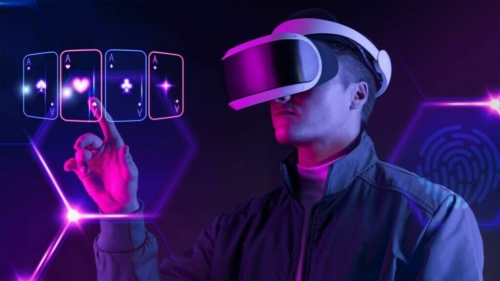Virtual Reality in Casino
 The casino industry has seen significant advancements in technology in recent years. One of the most exciting developments is the potential for virtual reality (VR) technology to revolutionize the industry. This technology can offer users more immersive gaming experiences and virtual tours of real-world casinos. This article will explore the potential benefits and drawbacks of using VR in casinos and examine how this technology could impact the industry.
The casino industry has seen significant advancements in technology in recent years. One of the most exciting developments is the potential for virtual reality (VR) technology to revolutionize the industry. This technology can offer users more immersive gaming experiences and virtual tours of real-world casinos. This article will explore the potential benefits and drawbacks of using VR in casinos and examine how this technology could impact the industry.
The Current State of Virtual Reality Technology
Virtual reality technology has come a long way in recent years. Technology has become more accessible and affordable, with hardware and software development advancements. VR technology offers users a fully immersive experience where they can feel like they are in a different world. As a result, the casino industry has begun to take notice of this technology and its potential to provide more interactive and engaging gaming experiences.
Potential Benefits of Virtual Reality in Casinos
Immersive Gaming Experience
One of the most significant benefits of VR in casinos is the ability to provide more immersive gaming experiences. With VR, players can feel like they are in a real casino, interacting with other players and dealers. They can even use hand controllers to pick up and move virtual chips and cards. This level of immersion can create a more exciting and engaging experience for players.
Virtual Tours of Real-World Casinos
VR can offer virtual tours of real-world casinos to users. This can be an excellent way for people to explore and experience different casinos without travelling to them. These virtual tours can be especially useful for people new to the casino world or looking to explore different casinos before deciding which one to visit in person.
Increased Engagement
VR can increase player engagement by providing more interactive and immersive gaming experiences. This could lead to longer playing times and higher revenues for casinos. It can also help attract younger players who are more comfortable with technology and looking for a more engaging gaming experience.
Reduced Costs
VR can reduce costs for casinos by eliminating the need for physical infrastructure and staffing. For example, a virtual casino can have unlimited space and tables without building more physical structures. This can be especially useful for casinos struggling to expand their physical space or looking to reduce costs.
Potential Drawbacks of Using Virtual Reality in Casinos
Addiction
One potential drawback of VR is that it can be addictive, and some people may become addicted to virtual gambling. This could lead to financial problems and other negative consequences. Therefore, casinos need to ensure that their virtual gaming experiences are responsible and do not contribute to problem gambling.
Loss of Touch with Reality
Another potential drawback of VR is that it can create an environment that is so immersive that users may lose touch with reality. This could lead to a distorted sense of what is real and what is not. Therefore, it is important for users to take breaks from VR and to ensure that they are still grounded.
Expensive Technology
VR technology is still relatively expensive, and not all casinos may be able to afford it. Maintaining and updating the technology can also be a significant expense. Therefore, it is important for casinos to weigh the costs and benefits of using VR and to ensure that they are making a sound investment.
 Impact of Virtual Reality on the Casino Industry
Impact of Virtual Reality on the Casino Industry
The impact of VR on the casino industry is likely to be significant. VR technology could change the way casinos are designed, as virtual casinos can be created without the constraints of physical space. This could lead to more creative and innovative casino designs.
Additionally, VR could impact the way people gamble. Virtual gambling could be more convenient and accessible than physical gambling, as users can play from anywhere with an internet connection. This could lead to more people gambling and potentially to more problem gambling.
Examples of Casinos Using Virtual Reality
Several casinos have already begun to experiment with VR technology. For example, the Grand Casino Helsinki in Finland has created a virtual casino where players can explore different gaming rooms and interact with other players. The virtual casino offers a range of games, including slot machines, blackjack, and roulette.
Another example is the Lucky VR casino, which offers a fully immersive VR gaming experience. Players can interact with other players and dealers, pick up virtual chips and cards, and play various games, including poker, blackjack, and roulette.
While these virtual casinos are still in their early stages, they have received positive user feedback and are showing promising results. However, it is important to note that not all virtual casinos have been successful. For example, the Alamo Casino in Las Vegas attempted to create a virtual casino in the early 2000s. Still, the technology needed to be more advanced at the time, and the project was ultimately abandoned.
Conclusion
Virtual reality has the potential to revolutionize the casino industry by providing more immersive gaming experiences and virtual tours of real-world casinos. While there are potential benefits, such as increased engagement and reduced costs, there are also potential drawbacks, such as addiction and loss of touch with reality.
It is important for casinos to weigh the costs and benefits of using VR and to ensure that their virtual gaming experiences are responsible and do not contribute to problem gambling. As VR technology advances, it will be interesting to see how it impacts the casino industry and how casinos adapt to this new technology.
